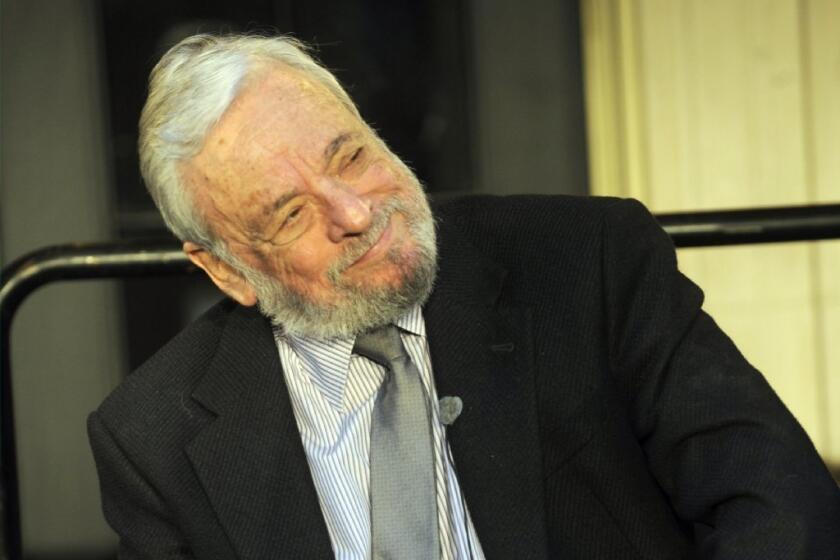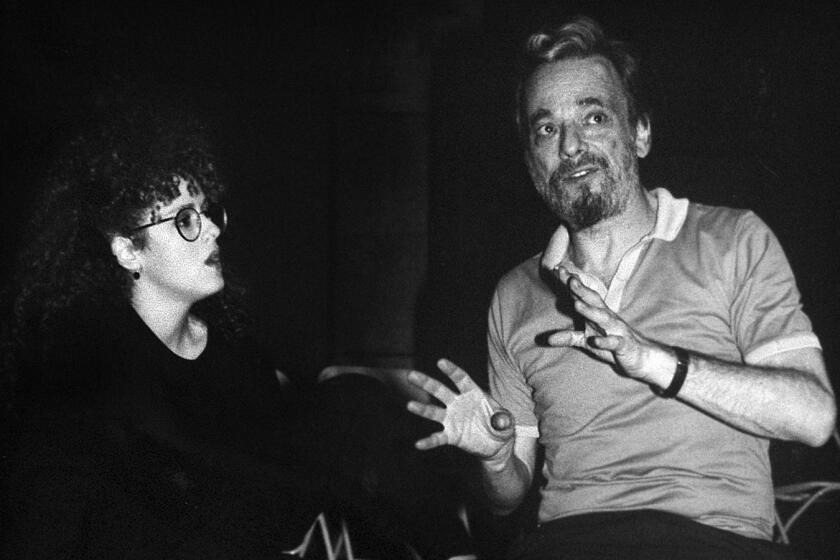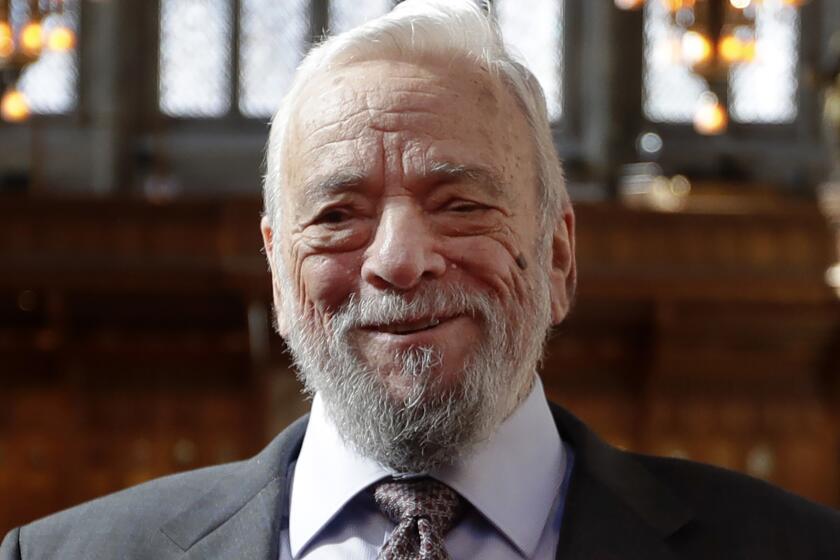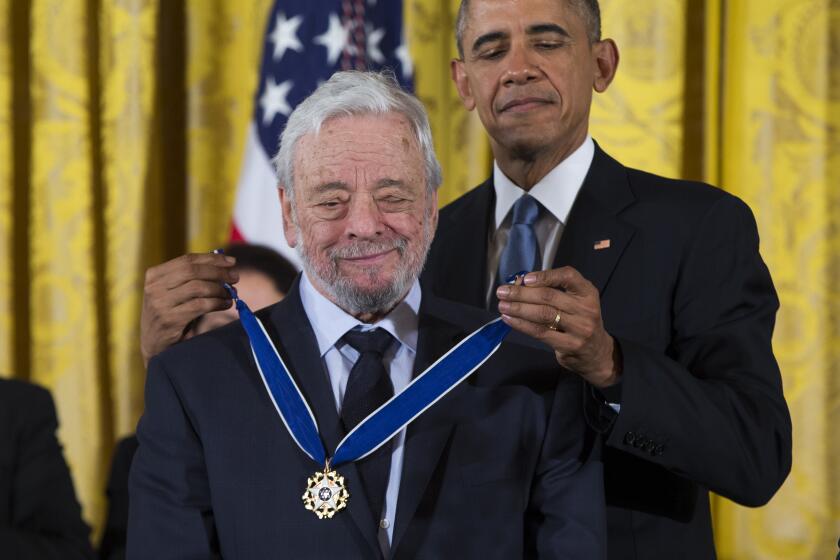Josh Groban remembers how Stephen Sondheim’s music ‘could take your breath away’
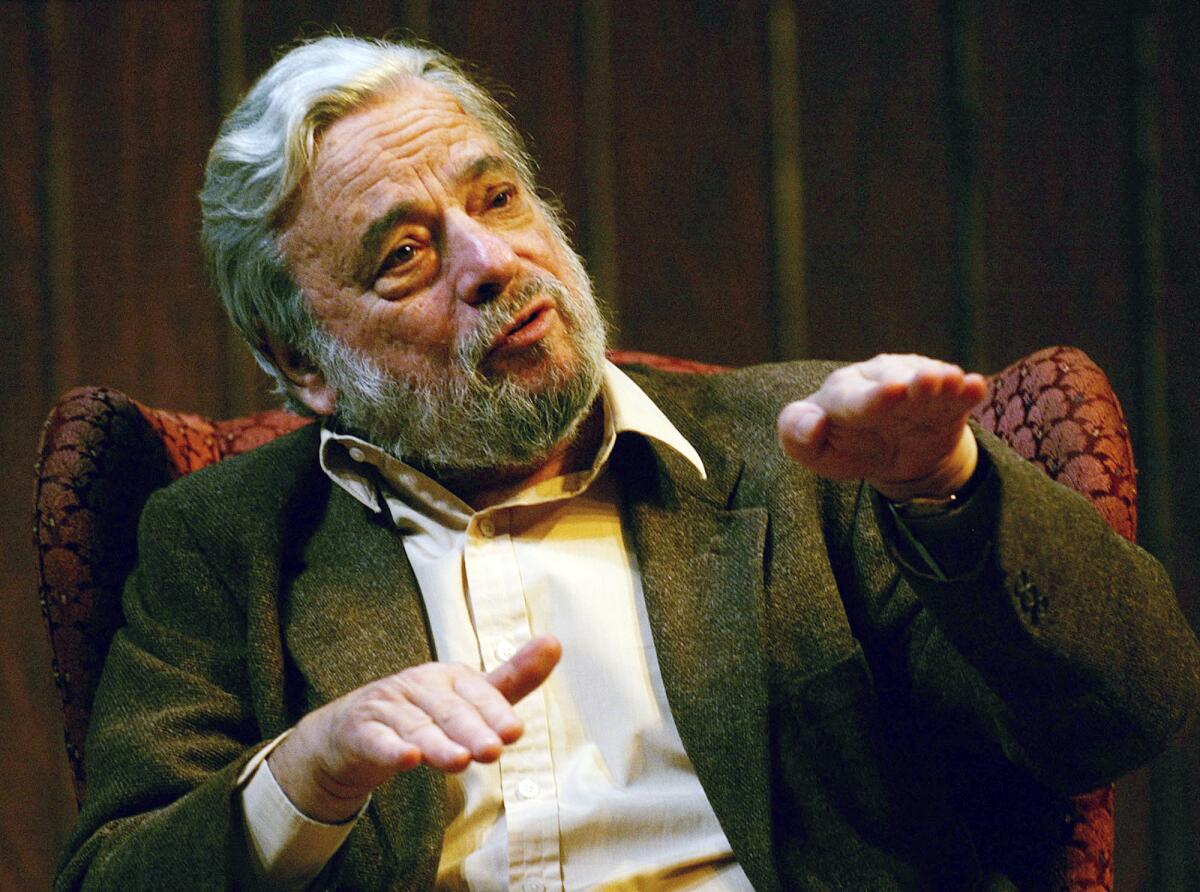
- Share via
Josh Groban can still remember the sight of a VHS copy of “Sunday in the Park With George” on a shelf in his parents’ home when he was growing up in Los Angeles.
“This was the version with Mandy Patinkin and Bernadette Peters, and I’d always see it and think, ‘That’s a funny cover — weird orange color, half painting and half jeans and boots,’” says the Grammy-nominated singer and actor famous for his big voice and his multiplatinum pop-classical records. “One day I asked my parents, ‘What is this?’ and they said, ‘It’s a musical. Do you want to watch it?’”
Thus was born a Stephen Sondheim fan.

In the years since, Groban, now 40, has returned often to the work of the brilliant and beloved composer and lyricist, who died Friday at age 91 after redefining the Broadway musical with shows including “Sunday in the Park,” “Company,” “Follies,” “Passion” and “Merrily We Roll Along.”
For his 2015 album, “Stages,” Groban mashed up “Children Will Listen” (from “Into the Woods”) and “Not While I’m Around” (from “Sweeney Todd”). And last year, not long after making his Broadway debut in the Tony-winning “Natasha, Pierre & the Great Comet of 1812,” he took part in a virtual 90th-birthday tribute to Sondheim that won rave reviews.
Groban wrote Saturday on Instagram about his admiration for the late icon; I called him later to hear a bit more.
A critic’s tribute to Broadway composer and lyricist Stephen Sondheim, a master of storytelling in song.
“Sunday in the Park,” which is about the French painter Georges Seurat, handles some pretty adult themes: creative inspiration, professional ambition, sexual frustration. Did you understand at age 8 or 9 what was going on in the show?
Steve had such a way of explaining those things in his music so that everybody could understand. Some of the lyrics were beyond me, but just the chords — the way it was structured and the idea that he could literally paint a picture of this man — I suddenly found myself understanding Seurat through that score. And then by understanding him, perhaps I could gain an understanding of the larger creative process. That’s what Steve did so beautifully: He awakened your curiosity without you even knowing it.
The theater legend behind seminal works from “West Side Story” to “Sweeney Todd” has a show on Broadway and a movie due soon.
Did you sense early on that his music was different from other composers’?
He was able to ignite both sides of the brain simultaneously. There are shows where I go in and I’m swept away by the music, the drama, the grandeur. And then there are shows where I’ve said, “Gosh, this is brilliant,” but the goose bump thing didn’t happen. Steve’s work stimulated the intellect; it challenged you to think deeper about yourself and about the world. At the same time, he could take your breath away with his music. That’s exceedingly rare.
What was the first Sondheim song you performed?
The first crack I took was at the Interlochen Arts Academy. They were putting on a production of “Sweeney Todd,” and I sang “My Friends” for the audition. I was, like, 14; I got cast as Prisoner Sent to Death No. 3, I think, but I loved the score so much that I just sat on the side of the stage and rooted for the show. They got better after that. The first time I was able to sing his work professionally was after I’d become friends with Barbara Cook. She really helped to guide me early in my career and introduced me to Steve early on. She encouraged me to sing “Johanna” from “Sweeney Todd” and asked me to sing “Move On” with her quite a few times. I got to sing for Steve too, which was extremely meaningful — allowed me to say thank you to him in a way I don’t think I ever would’ve been able to with words.
Hugh Jackman, Audra McDonald, Anna Kendrick, Sarah Silverman and Brian Stokes Mitchell paid their respects Friday to the esteemed musical theater icon on social media.
People say the music is difficult to sing.
Technically it’s very challenging — very rangy. The roles that he writes usually take you out of the traditional voice types: baritone, tenor, alto, soprano. You have to fit into those molds, but you also have to have a lot more up your sleeve if you’re going to sing the whole score. But like all the great writers, he provides so much. Anytime you have a question about the whys of the show or of a character, it’s all in the work. And they’re the kind of shows that you continue to discover. Years and years and years after you first hear a song, you can find something new in a lyric that you hadn’t recognized before. That’s the other wonderful challenge of his music: Just when you think you know all there is to know about it, there’s more.
A look at Stephen Sondheim, the award-winning composer-lyricist with shows such as “Company,” “Follies” and “Sweeney Todd.”
Beyond “Send in the Clowns,” Sondheim didn’t have many big pop crossover moments. Why do you think that is?
For theater writers, it’s a narrow window into that world because you’re writing with really long arcs. I’ll never forget: He invited me over to his apartment to chat between [“Great Comet”] shows; I had a two-show day, and I ran — ran, ran, ran — to go have a half-hour with him. He was asking me questions about the music world, and I was asking him about his process. And this topic came up, the idea of a three- or four-minute hit. I asked him, “Do you ever, just for fun, write snacks? A song where the entire story is going to be in these four minutes?” And he said no. He said, “If it’s not a story that I love and want to see through from beginning to middle to end, I don’t really want to dive in.” The process was so long-form for him. We talk about album artists and one-hit wonders, right? He was the album artist.
More to Read
The biggest entertainment stories
Get our big stories about Hollywood, film, television, music, arts, culture and more right in your inbox as soon as they publish.
You may occasionally receive promotional content from the Los Angeles Times.
